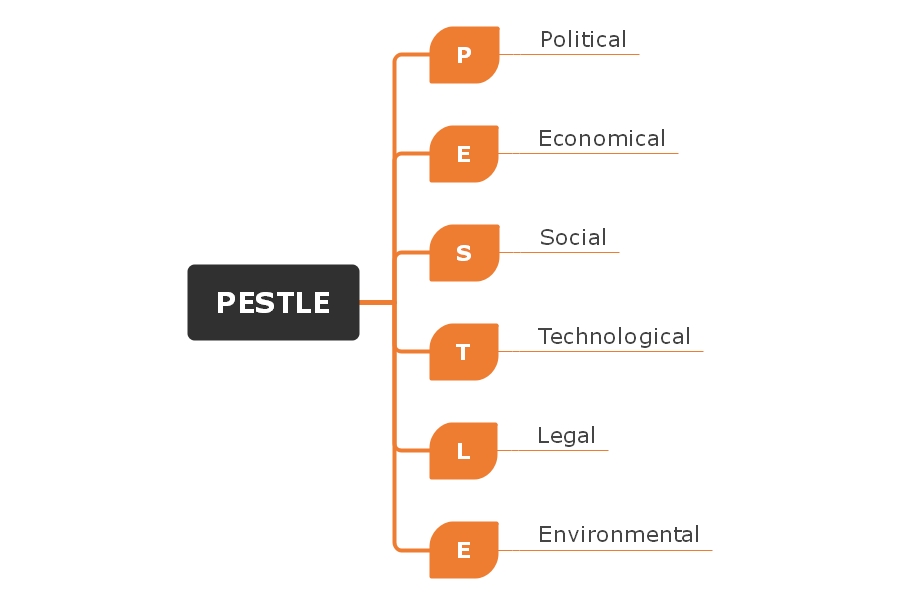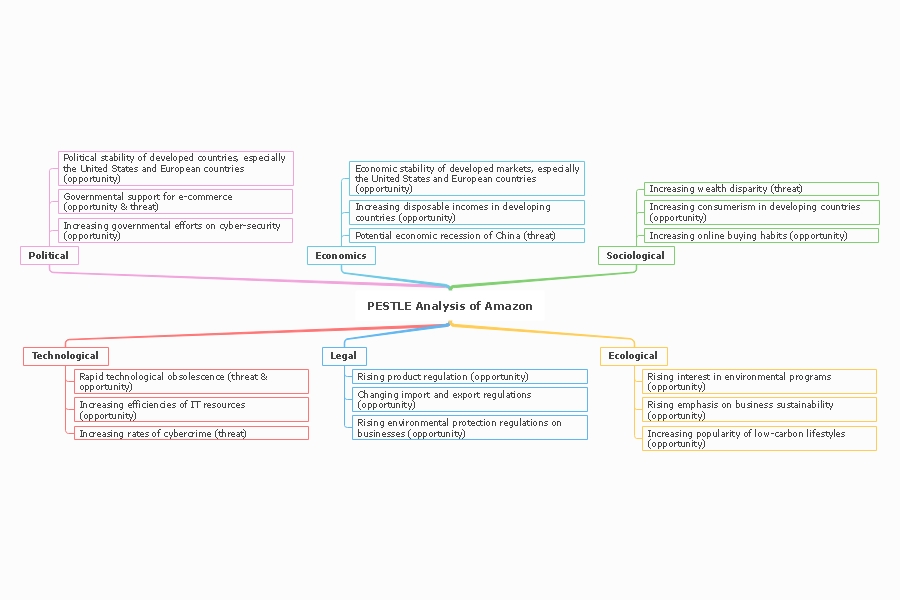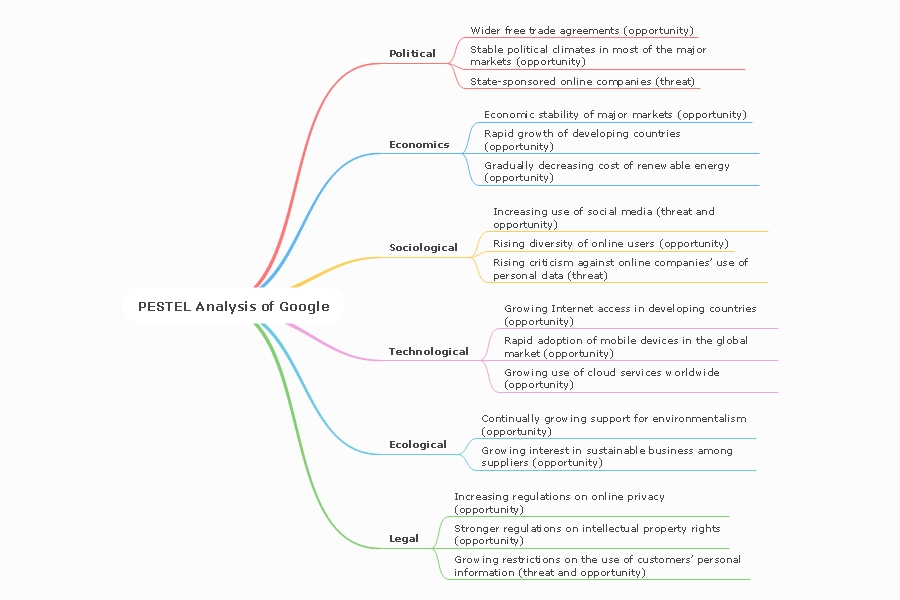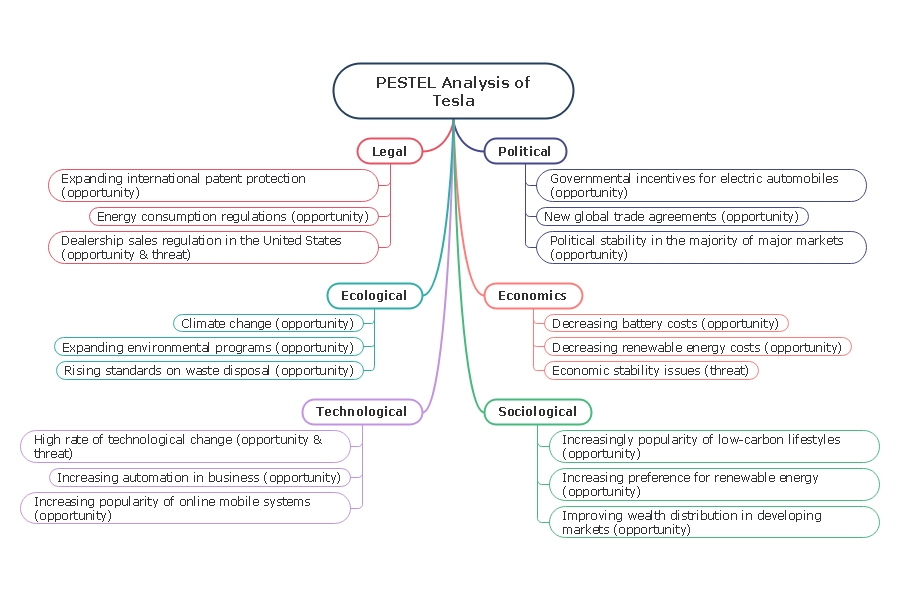PESTLE Analysis: Explained with Examples & Templates
Edraw Content Team
Do You Want to Use PESTLE Analysis?
EdrawMind helps move ideas forward, faster and better. Learn from this PESTLE Analysis complete guide to know everything about PESTLE. Just try it free now!
1. What is PESTLE Analysis?
The PESTLE analysis is a tool to identify macro (external) forces an organization faces in its business. More specifically, PESTLE analysis studies the external challenges of a business. And guides to overcome them.
The external challenges are Political, Economic, Social, Technological, Legal, and Environmental. The word "PESTLE" is an acronym for these six factors.
PESTLE analysis is an important marketing tool. It helps every business identify significant changes in the broad business background, thus helping in better strategic business planning.
There are many variants of the analysis to fulfill the needs of businesses with unique requirements. They can use variants as per their needs. For example, if the technological factor doesn't matter to an industry, they can choose a variant that excludes it. A few widely used variants of PESTLE analysis are STEEPLE, SLEPT, and PESEL.

2. What are the 6 PESTLE Factors? With Complete Lists
Now we'll discuss each factor of the PESTLE analysis with examples and try to understand how they impact a business.
1. Political:
The P stands for political, the first and an essential factor of the PESTLE analysis model. Political factor determines how government and government policy may impact a business. Here we analyze the government's policy-making patterns regarding business laws and regulations like tax guidelines.
It also deals with business to political relations and their impacts on the overall market. The political stability or instability in a country and their possible outcomes. Government's behavior with businesses in general. The political factors deal with such and many other questions.
Summarization of the political sub-factors:
- Government stability
- Political policy
- Tax guideline
- Fiscal laws
- Trade regulation
- Safety regulation
- Employment laws
2. Economic:
E stands for economic. The economy significantly affects a business's organizational operations. For example, equipment prices and maintenance costs increase with inflation and interest rates increment. Also, with a rise in the currency exchange rate, the duty on imports of raw materials increases, ultimately leading to a rise in the product price. The economy directly impacts the growth and performance of the industry. The end consumer's financial state is also essential. An affordable and quality production puts a base of a successful business; we can achieve it only when the economic factor is carefully analyzed.
Summarization of economic sub-factors:
- Inflation rates
- Interest rates
- Economic growth
- Employment or unemployment rates
- Currency exchange rates
- Raw material costs
3. Social:
S is for social. This factor helps a business understand its end consumer needs. The focus remains on the social environment, public behavior, and identifying emerging trends among the people. It deals with the customers' values, hopes, desires, and fears. It also discusses what motivates or disgusts the general masses and why. Careful analysis of social factors is crucial for a good business plan and strategy. The social factor helps companies do a robust customer analysis to solve their customers' problems with their products or service.
Summarization of social sub-factors:
- Demographic characteristics
- Education levels
- Custom and values of the population
- Cultural trends
- Attitude changes
- Changes in lifestyles
4. Technological:
Technological factors consider the rate of technological development and innovation that could affect a market or industry. Technology is overgrowing, and the industry should be able to acquire that technology as soon as possible to remain in the race before the competition overtakes the market.
Technology also poses threats. For example, it is also possible that a particular product could be replaced by a much cheaper and more advanced alternative of another company. Therefore, keeping oneself updated on the new trends and advancements in an industry is necessary. Every organization must possess the latest technology required to develop and enhance its products or services.
Summarization of technological sub-factors:
- Changes in digital or mobile technology
- Automation
- Research
- Development
5. Legal:
It is crucial for an organization to know what is legal and allowed within the territories of the country they operate. They also must be aware of any possible change in laws or legislation in the country and its impact on industry operations.
Summarization of legal sub-factors:
- Employment legislation
- Consumer law
- Healthy and public safety
- Local trade regulation and restrictions
- International trade regulation and prohibitions
6. Environmental:
A successful business model gives importance to the environment. Carbon footprint, climate change, and waste disposal are critical for it. Also, the environmental impacts are essential for the low cost and good quality production. For example, a product suitable for a cold atmosphere should be prepared in a low-temperature area rather than investing in air conditioning. Also, proper environmental conditions ensure that the products remain fine for a more extended period
Summarization of environmental sub-factors:
- Climate
- Recycling procedures
- Carbon footprint
- Waste disposal
- Sustainability
3. When to use PESTLE Analysis?
PESTLE analysis is used before a strategic business decision. The analysis effectively detects and understands broad, long-term trends in the business background. Therefore, it is extensively used in a range of business planning situations. Let's see where we can use it.
Strategic business planning
With PESTLE analysis, we can obtain contextual information about the business direction, whether the business is growing or not? Growth targets, brand positioning, and risks to productivity ratios.
Expansion of the business
The PESTLE analysis may also help determine when and where a business should expand. It could be determined by considering labor costs, tax laws, and the need for the product where the industry plans to expand.
Workforce Planning
PESTLE analysis can help to plan the required workforce for an organization. For example, a technical workforce will be required for a technology-related business. PESTLE analysis help to choose the right workforce by considering factors like availability of labor, availability of skilled labor, and the cost.
Product development
A PESTLE analysis help determines if a product or service still fulfills the needs of the consumers in the marketplace. It may also tell what product would suit the current market conditions. Also, it reveals why a product fails or succeeds in similar business conditions.
Marketing Planning
PESTLE analysis helps in marketing a brand or product effectively. It deals with the factors required to sell a product proficiently to the customers. Many major organizations use the PESTLE analysis for product promotion and marketing.
Organizational change is a PESTLE analysis example. It deals with the possible opportunities and threats around labor changes, such as skills, increment or decrement in the labor cost, shortages, or current workforce capabilities.
4. How to do PESTLE Analysis?
Before doing PESTLE analysis, it is better to arrange a team of experts for the task. A team could be organized based on six PESTLE factors. It is necessary to obtain information on each area of the PESTLE model. Every element has its importance. If anything is left out, the analysis would not be much helpful. Therefore, field experts are required for this analysis, i.e., a technical team member could be hired to research the technological aspects. Likewise, an environmentalist could be employed to study the environmental factors.
There are ten steps to take to do a successful PESTLE analysis.
- Identify the scope of research that covers the present and possible future scenarios.
- Decide who will collect the information and how.
- Identify appropriate sources of information.
- Gather the information. Make sure to arrange the information correctly to be used again easily.
- What did you find? Analyze the information carefully.
- Make a list and put the items in terms of their importance. Most important things go first, and less important things go last.
- Identify the options you have to address the issues.
- A discussion document for all stakeholders.
- Discuss the findings with stakeholders.
- Discuss the plan and decide on actions to take.
5. PESTLE Analysis Examples
Here are three examples of PESTLE analysis of three highly successful companies.
- Amazon
![amazon's pestle]() Click here to download EdrawMind
Click here to download EdrawMind
(For Win)Click here to download EdrawMind
(For Mac)Click here to download EdrawMind
(For Linux)Amazon PESTLE analysis indicates the significant threats that might pose a problem for the company. Also, it shows the growing opportunities that are being developed with the ever-increasing technology and economy-these opportunities aid in holding their place in the online market.
- Google
![google pestle]() Click here to download EdrawMind
Click here to download EdrawMind
(For Win)Click here to download EdrawMind
(For Mac)Click here to download EdrawMind
(For Linux)Google PESTLE Analysis tells that they have many opportunities and some threats. They must prepare a solid plan which can aid them to survive in the highly certain economic factors in any competitive market. Google Should develop a more secure medium for the users.
- Tesla
![tesla pestle]() Click here to download EdrawMind
Click here to download EdrawMind
(For Win)Click here to download EdrawMind
(For Mac)Click here to download EdrawMind
(For Linux)Tesla's PESTLE Analysis example highlights many vital elements that have been helpful in the company's growth. From the economic perspective, the company has many challenges, but at the same time, from environmental and technological factors company's rapid growth is evident.
6. Pros and Cons of PESTLE Analysis
Pros
-
It encourages critical thinking.
-
It helps to prepare the business for the future.
-
It helps to manage business risks and threats.
-
It helps businesses capitalize on new opportunities.
-
It is a straightforward approach with a simple framework.
Cons
-
It takes a lot of time to process.
-
It involves many steps.
-
It needs to be done at regular intervals.
-
External factors could change quickly, so it cannot be easy to present and analyze up-to-date information.
7. Key Takeaways
PESTLE analysis helps in the development and growth of businesses and organizations. It helps to analyze strong and weak areas of industries. A proper PESTLE analysis report may help you grow your business. With EdrawMind, you can create eye-appealing PESTLE analysis graphs and reports for your business with a few clicks and easily share them with your team members. You can also select from 100s of already present templates and customize them according to your needs.
You May Also Like
Health Mind Map Complete Guide With 10+ Examples
EXAMPLES & TEMPLATES
Personal Mind Map Complete Guide With 10+ Examples
EXAMPLES & TEMPLATES
Business Mind Map Complete Guide With 30+ Examples
EXAMPLES & TEMPLATES
Mind Map Ideas for Students: Explained with 30+ Examples
EXAMPLES & TEMPLATES
Biology Concept Map Complete Guide With 30+ Examples
EXAMPLES & TEMPLATES


